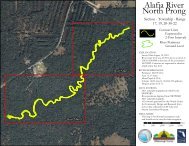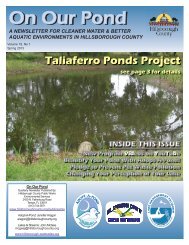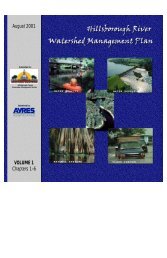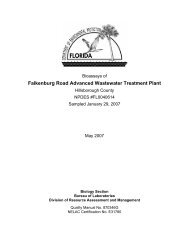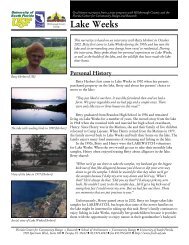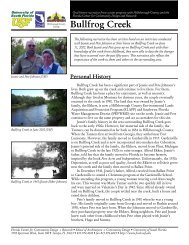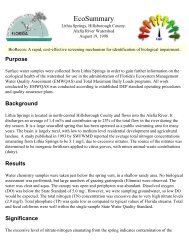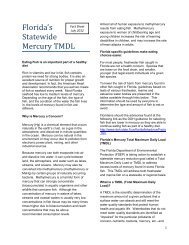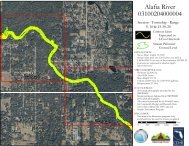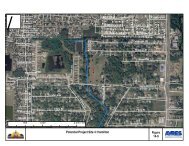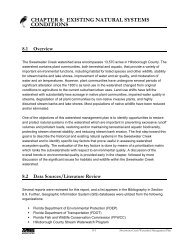- Page 1 and 2: CHAPTER 8: EXISTING NATURAL SYSTEMS
- Page 3 and 4: CHAPTER 8Using the data described i
- Page 5 and 6: CHAPTER 8Land uses and cover types
- Page 7 and 8: LegendRoadsHydrographyAgriculturalB
- Page 9 and 10: CHAPTER 8Hardwood conifer mixed for
- Page 11 and 12: CHAPTER 8Mangrove swamps (612)The a
- Page 13 and 14: CHAPTER 8consist solely of mud into
- Page 15: CHAPTER 8use. Urban inactive land i
- Page 19 and 20: State Road 54Pasco CountyHillsborou
- Page 21 and 22: State Road 54Pasco CountyHillsborou
- Page 23 and 24: CHAPTER 8buffer zones should be est
- Page 25 and 26: CHAPTER 8Factors such as the width
- Page 27 and 28: State Road 54Pasco CountyHillsborou
- Page 29 and 30: CHAPTER 88.5.4 Biological Indicator
- Page 31 and 32: State Road 54Pasco CountyHillsborou
- Page 33 and 34: CHAPTER 8The presence of wildlife o
- Page 35 and 36: CHAPTER 8Table 8-9Protected Animal
- Page 37 and 38: CHAPTER 8problems; and8. informing
- Page 39 and 40: CHAPTER 8the entire surface of some
- Page 41 and 42: CHAPTER 8Wild TaroThe wild taro is
- Page 43 and 44: CHAPTER 8The FDEP Bureau of Land Ac
- Page 45 and 46: State Road 54Pasco CountyHillsborou
- Page 47 and 48: CHAPTER 8Funding Program (NRTFP). T
- Page 49 and 50: CHAPTER 8Hillsborough CountyWetland
- Page 51 and 52: CHAPTER 84. Hillsborough County Str
- Page 53 and 54: CHAPTER 8innovative, interdisciplin
- Page 55 and 56: CHAPTER 8• Developing and support
- Page 57 and 58: CHAPTER 88.9 BibliographyThe attach
- Page 59 and 60: CHAPTER 8Southwest Florida Water Ma
- Page 61 and 62: CHAPTER 8Chinese laddere brake, Pte
- Page 63 and 64: CHAPTER 8: EXISTING NATURAL SYSTEMS
- Page 65 and 66: CHAPTER 8Using the data described i
- Page 67 and 68:
CHAPTER 8Land uses and cover types
- Page 69 and 70:
LegendRoadsHydrographyAgriculturalB
- Page 71 and 72:
CHAPTER 8Hardwood conifer mixed for
- Page 73 and 74:
CHAPTER 8Mangrove swamps (612)The a
- Page 75 and 76:
CHAPTER 8consist solely of mud into
- Page 77 and 78:
CHAPTER 8use. Urban inactive land i
- Page 79 and 80:
CHAPTER 8enhance drainage for rows
- Page 81 and 82:
State Road 54Pasco CountyHillsborou
- Page 83 and 84:
State Road 54Pasco CountyHillsborou
- Page 85 and 86:
CHAPTER 8buffer zones should be est
- Page 87 and 88:
CHAPTER 8Factors such as the width
- Page 89 and 90:
State Road 54Pasco CountyHillsborou
- Page 91 and 92:
CHAPTER 88.5.4 Biological Indicator
- Page 93 and 94:
State Road 54Pasco CountyHillsborou
- Page 95 and 96:
CHAPTER 8The presence of wildlife o
- Page 97 and 98:
CHAPTER 8Table 8-9Protected Animal
- Page 99 and 100:
CHAPTER 8problems; and8. informing
- Page 101 and 102:
CHAPTER 8the entire surface of some
- Page 103 and 104:
CHAPTER 8Wild TaroThe wild taro is
- Page 105 and 106:
CHAPTER 8The FDEP Bureau of Land Ac
- Page 107 and 108:
State Road 54Pasco CountyHillsborou
- Page 109 and 110:
CHAPTER 8Funding Program (NRTFP). T
- Page 111 and 112:
CHAPTER 8Hillsborough CountyWetland
- Page 113 and 114:
CHAPTER 84. Hillsborough County Str
- Page 115 and 116:
CHAPTER 8innovative, interdisciplin
- Page 117 and 118:
CHAPTER 8• Developing and support
- Page 119 and 120:
CHAPTER 88.9 BibliographyThe attach
- Page 121 and 122:
CHAPTER 8Southwest Florida Water Ma
- Page 123 and 124:
CHAPTER 8Chinese laddere brake, Pte
- Page 125 and 126:
CHAPTER 9: WATER SUPPLY9.1 Overview
- Page 127 and 128:
CHAPTER 9Hillsborough County Compre
- Page 129 and 130:
CHAPTER 9Figure 9-1A Tampa Bay Wate
- Page 131 and 132:
Pasco CountyHillsborough CountyEldr
- Page 133 and 134:
CHAPTER 9Total per capita water use
- Page 135 and 136:
CHAPTER 9Groundwater levels in the
- Page 137 and 138:
CHAPTER 9Furthermore, with increasi
- Page 139 and 140:
CHAPTER 9The recovery strategy invo
- Page 141:
CHAPTER 9Southwest Florida Water Ma



